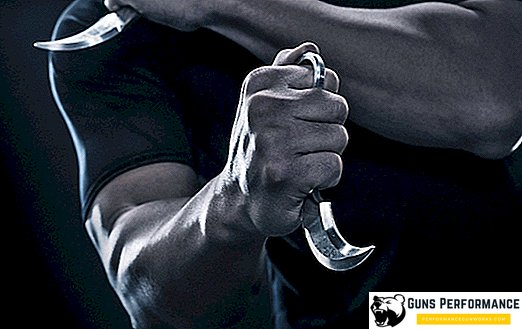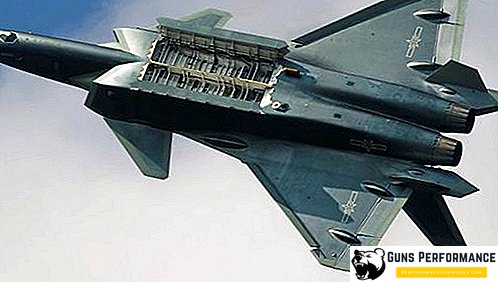
The knife kerambit - exotic curved blade, became popular thanks to computer games. It may seem like a deadly weapon. In fact, its area of application is somewhat different, and depends heavily on the climate of the region in which it is used.
Real karambit (the so-called classic version) is the traditional weapon of the peoples of the Malay Archipelago. It is a curved fixed blade with internal sharpening. A simple handle has a large ring for the finger. Traditionally used reverse grip, while strikes were made from the bottom up, as if ripping the enemy. It is believed that Karambit was used by Malay warriors in close combat, when it was difficult to use other weapons. Now there are many schools of knife fighting, which consider Karambit an ideal weapon for self-defense.

The history of the appearance of kerambit
Karambits appeared on the Malaysian islands around the 14th century (the first images of this knife date back to this period). His invention is attributed to the people of Minankbau, who used knives of this form in battles with other nations. In addition, because of its shape, kerambit was ideal for removing and processing animal skins. Naturally, the combat and economic kerabits differed greatly from each other in the size and shape of the handle.
There are several versions of the appearance of Karambit. It is worth noting that not one of them is not considered 100 percent reliable.
- The first legend is connected with the war between the people of Minankbau and the inhabitants of the island of Java. According to her, the wise rulers of two nations decided not to exterminate each other in bloody battles, but to resolve the dispute by a duel between the two best buffaloes on each side. The Javanese led a huge buffalo to the battle, seeing that the Minangbau turned pale. But when they saw which rival the giant was displayed by their king, they were completely desperate. On the battlefield ran a small puny buffalo, with sharp crooked knives tied to his horns. The giant paid no attention to such a rival, and the hungry kid, taking a huge buffalo for his mother, rushed to look for his udder. Sharp blades ripped up the rival's belly and so the people of Minangbau won the battle;
- The second version is more prosaic, but more real. According to her, kerabits originated from the agricultural tools of the Malays, from the sickle (the Japanese weapon Kama was developed in a similar pattern). This version is also supported by the fact that the island peoples did not have a high combat potential and could not afford highly specialized items for war. Naturally, the royal warriors had an impressive arsenal, but the majority of the inhabitants had only peasant implements of labor;
- According to the third version, the spurs on the legs of roosters served as a prototype of kerambit. Favorite entertainment for Malays were cockfights. For entertainment, small curved blades were tied to the spurs of roosters, repeating in their shape the spurs. Noticing how effective the blows with such spurs were, the islanders began to make combat knives of this form;
- According to the fourth version, kerambit was invented precisely as a combat weapon, and is a kind of bagh nakh (Indian knives knuckles) adapted for various household purposes.
Any of these versions is not proven, the truth lies somewhere between them.

Types of classic kerabits
There are several varieties of ancient kerabit knives, which are the progenitors of all modern models.
- Classic kerambit Minang - is a weapon of the Minangbau people. It was this form that prompted researchers to believe that kerambit originated from the sickle;
- Minang Harimau - its shape resembles the tiger's claws. This theory is confirmed by the drawings of tigers on the handles of these knives;
- Taji java karabits - their main difference is the metal ring on the handle (in previous models this is a tree ring);
- Kuku Makhan - kerambit with a minimum bend of the blade;
- Lavi Ayyam - this is the very famous cock spur from the legend;
- Besar - Javanese Karambit, used only in battles. Differs in a long and massive blade;
- Burung - kerambit in the form of a bird's beak (this word is translated as a bird).
The use of Karambit in combat occurred in cases of loss or damage of the main weapon. Karambit was the weapon of last chance. This does not apply to local robbers and peasants, for whom combat ceramite was the main weapon of attack or defense. Often, small kerabits were worn by noble women of that era for protection. Naturally, the assassins loved using these weapons for their own purposes. Carrambite smeared with plant poison caused painful death due to a single cut.
At the end of the twentieth century, Karambits spread throughout the world. Their form began to change in favor of fashion and user needs. Folding kerabits, knives with serreytor, double-edged blade appeared.
The effectiveness of kerambit

Is cerambit as effective as teachers of self-defense schools enthusiastically tell? Of course, in the hot climate of Malaysia, any scratch can become inflamed and fester. Any shallow long wound, which causes kerambit, can lead to fatal blood loss or gangrene. But many people do not pay attention that all the clothes of the inhabitants of these places are a loincloth or lightweight clothing.
In our latitudes, where most of the time the body is protected by thick clothing, the effectiveness of kerambit is rapidly falling. Kerambit work comes down to face cuts or open hands. Cutting blows to the face may qualify by law as intentional disfigurement.

Karambits are very interesting knives with a long history. If you decide to purchase such a knife for yourself - choose the option with a fixed blade, such kerambit is most reliable in operation.












